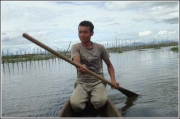 This series by Thingnam Anjulika Samom deals with the impact of modernisation, development and state policy on the traditional use, control and management of Loktak lake, the largest common property aquatic resource in Manipur. The Loktak Hydropower Project commissioned in 1983 has damaged the ecology of the largest freshwater lake in the northeast, and has altered the culture, agricultural and livelihood patterns of communities residing around Loktak. The series looks at what this common property resource used to be and what it has become.
This series by Thingnam Anjulika Samom deals with the impact of modernisation, development and state policy on the traditional use, control and management of Loktak lake, the largest common property aquatic resource in Manipur. The Loktak Hydropower Project commissioned in 1983 has damaged the ecology of the largest freshwater lake in the northeast, and has altered the culture, agricultural and livelihood patterns of communities residing around Loktak. The series looks at what this common property resource used to be and what it has become.
Loktak, the 300-square-km lake is spread over three districts in the valley – Imphal West, Bisnupur and Thoubal and covers 61% of the total identified wetlands of Manipur. Besides being the source of livelihood for hundreds of people, Loktak also houses the floating national park Keibul Lamjao, the only home in the world to the endangered Sangai deer. It is not only the geographical topography of the lake that has changed in the last few decades. The lake is also beset by increasing pollution, siltation, rapid proliferation of phumdis and the commissioning of the Loktak hydel project in the 1980s Manipur or Imphal River, with the Loktak lake forming the headwaters to provide regulated storage for power generation.
The lake water is maintained at a permanent high level, not only submerging its identity as well as of the smaller lakes but also changing the hydrological regime, ecosystem and life culture of the people living in and around the lakes. The Ithai barrage has played a significant role in the proliferation of loose phumdi which are now choking the lake. It led to the congestion and stagnation of the vegetation mass in the lake and a reduction in the clear water surface. It also encouraged the process of eutrophication in the lake.
The recent legislation passed by the state government, the Manipur Loktak Lake (Protection) Bill 2006, is also discussed as it prohibits the building of huts or houses on phumdis inside a core zone of the lake apart from a ban on engaging in athapum fishing in the lake.
However, even as environmentalists, government agencies and the general public try to address the issue of proper management and conservation of Loktak Lake and its associated wetlands, there seems to be no concerted effort between the different stakeholders including the people living on the periphery of the lake who are dependent on its resources for their livelihood. The articles can be viewed at the following links to the InfoChange website -
Part I: Ditty for a dying lake
Part II: There’s nothing you didn’t get from Loktak
Part III: The trade-off between food security and ‘development'
Part IV: From owners to ‘occupiers'
Part V: Scions of a changing lake
/articles/ecological-destruction-loktak-largest-freshwater-lake-north-east-india-five-part-fes